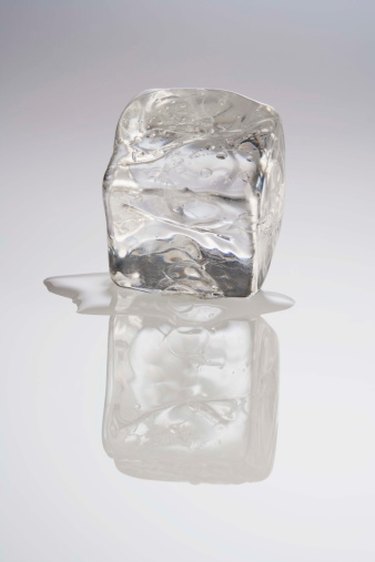
Watercolor paints produce spectacular effects if you use the correct techniques. Painting a cloudy sky, sunny sky, reflections or ice require completely different techniques. Painting ice requires patience and time, because you let areas dry thoroughly between steps, but the actual painting process is simple. Use the same basic techniques when you paint ice cubes, icicles hanging from trees or a distant frozen landscape, and get excellent results.
Ice Cubes
Video of the Day
Set a piece of ice on a saucer, and place it on a flat surface with a light aimed at its surface. Lightly sketch in what you see using a light pencil. You see the colors behind and under the ice along with the reflected light. Paint in the areas where you see color showing through the ice cube. Leave white paper showing toward the edges of the ice cube. The white areas look icy. Paint areas around the ice cube, and add any reflections of the ice in the melted water around the ice cube.
Video of the Day
Hanging Icicles
Icicles blend the colors around them with white. When you draw an icicle, draw the areas carefully. Paint masking fluid over the white areas, and let it dry. Paint the darker areas with the appropriate color. If the icicle is against something brown, make the icicle a slightly lighter shade of brown. Once it dries, rub off the masking fluid with your fingers or a kneaded eraser, and add in some thin color washes that blend the white areas and colored areas. While the wash is still wet, draw a dry paper towel in a downward motion on the damp icicle. This makes a highlight going down the icicle.
Frozen Landscapes
Frozen landscapes full of ice and snow are easily painted with a little patience. Start by using cooler colored paints. Lean more toward the blues, greens and purples, which give the image a cooler feel. Draw in the basic sketch on the watercolor paper, and paint in thin washes of the colors. Leave a lot of areas of the page white. If there are trees or shrubs, paint them, leaving some areas white toward the tops of limbs where snow sticks as it falls, and some areas under the limbs white where an icicle droops. If you get too much color in an area, lift it up by dabbing a piece of paper towel or a sponge into the area. It lifts the color up easily. Wet ice is reflective, so paint in reflected color coming from things around icy areas. If you have a frozen pond, the trees and sky reflect off the surface.
Icy Windows
Draw the windows using a light pencil, and put a handful of paper towels and rough sponges by the drawing. Scrunch up the paper towels. Take one rough sponge, and dip it in masking fluid. Dab the masking fluid around the edges of the window. Let it dry thoroughly. Paint the areas around the windows first, and let dry thoroughly. Paint the scene showing through the window quickly, and press the rough sponge around the edges of the windows to lift the paint. Quickly, press the paper towels around the edges, lifting more paint. Wait until the paint dries completely, and rub off the masking fluid. This leaves white, icy-looking areas around the edges of the windows.